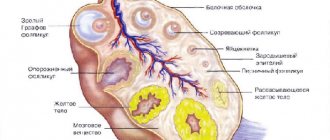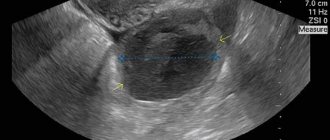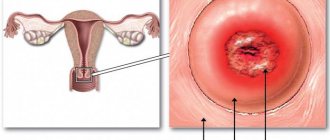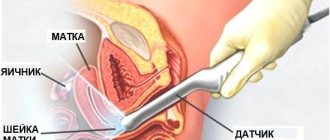What it is
Structure of the ovary
A corpus luteum cyst is usually diagnosed in the early stages of pregnancy and is a rounded small neoplasm with fairly clear and even contours, located on one of the two ovaries. Inside the tumor is filled with yellow liquid, sometimes with bloody streaks.
Every month during the menstrual cycle, one (less often two or three) follicle matures in one of the woman’s ovaries, as a result of the natural rupture of which (ovulation) the egg penetrates the uterine cavity and is fertilized. In place of the ruptured follicle, a corpus luteum appears, which actively begins to produce progesterone, a hormone that allows the fertilized egg to “fix” itself in the uterine cavity. If conception does not occur, and there is no hormonal disruption in the functioning of the female body, the corpus luteum naturally dies and is excreted through menstrual bleeding.
The corpus luteum got its name because of lutein, which gives it a specific color, the appearance of which is often compared to the formation of a hematoma - first the body turns red, then turns blue, and then gradually begins to turn yellow. This is due to blood entering the gland when a mature follicle ruptures.
During pregnancy, the corpus luteum does not regress, but, on the contrary, increases in size and begins to produce even greater amounts of progesterone, often leading to the formation of a so-called functional cyst, which is prone to growth due to the serous fluid filling it.
The reasons for the appearance of such a neoplasm have not yet been studied - the occurrence of a tumor is influenced by a large number of factors: most often, a cyst develops if a blood vessel ruptures simultaneously with the follicle. The level of blood clotting also plays an important role.
Is pregnancy possible with a cyst and what are the chances of getting pregnant with a corpus luteum cyst?
Pregnancy may occur. If hypofunction of the corpus luteum is detected during pregnancy, then it can spontaneously terminate. Because the organ will produce insufficient amounts of progesterone for the development of the placenta.
The factors that cause cyst formation during pregnancy are not exactly known. Neither age nor lifestyle directly influence its occurrence. The appearance of a cyst is promoted by:
- inflammatory processes in the uterus and appendages;
- circulatory disorders in the pelvic organs;
- hormonal disorders;
- previous abortions;
- emergency contraception;
- nervous overload and stress;
- the effect of infertility medications on the ovaries, including stimulation of ovulation;
- strict diet and fasting;
- genetic predisposition to the formation of cysts.
Symptoms
All processes associated with the formation and pathological growth of the formation are practically asymptomatic - usually it is possible to detect a cyst only during a routine examination by a gynecologist or ultrasound. But sometimes the expectant mother may feel slight discomfort and pain in the lower abdomen, most often on the side where the tumor appeared.
This indicates not only the presence, but also the growth of the cyst. The growth of a tumor in a woman occurs against the background of an increase in temperature, as well as pain after and during sexual intercourse and even minor physical exertion.
In fairly rare cases, a woman may suddenly feel a sharp pain in the lower abdomen (right or left). This is often accompanied by vomiting, gas formation or constipation, and intoxication.
Diagnostics
A woman usually cannot independently suspect the presence of a tumor; the process of development of neoplasms is asymptomatic.
A corpus luteum cyst is discovered by chance during an ultrasound of the genitourinary organs.
This is what a corpus luteum cyst looks like on ultrasound
For a more accurate diagnosis of a neoplasm, a laparoscopy method is used, an analysis of the woman’s hormonal level is carried out, as well as a biopsy of the cyst in order to exclude a malignant neoplasm.
During a vaginal examination, a gynecologist can detect not only an enlarged (pregnant) uterus, but also a round, fairly mobile neoplasm, located, as a rule, on the side or not the back wall - this is a corpus luteum cyst. The tumor is painless and appears as a rounded tumor on a thin stalk, with a thickened capsule and multiple septa. Often in the cavity of such a cyst there is serous fluid and blood clots.
Early danger
Once formed, a cystic formation has no more than a 2-3% chance of developing complications. They can be represented by the following states:
| Complication | Description |
| Hemorrhage into the cyst cavity | It occurs only if the vessels pass in close proximity to the tumor (anatomical features of the location). The hemorrhage itself cannot be treated and is asymptomatic - no clinical picture is formed and is confirmed only by ultrasound data. |
| Ruptures of cysts with release of contents into the abdominal and pelvic cavity | Observed, for example, with blunt abdominal injuries. In this case, the woman may not feel a change in her condition immediately, which is explained by the small size of the cysts. Manifestations of peritonitis begin gradually with all the classic symptoms (severe diffuse abdominal pain, fever, vomiting, diarrhea once or twice, positive peritoneal symptoms). This condition requires hospitalization and surgery. Diagnostic laparoscopy is immediately performed for differential diagnosis with other conditions that also give the clinical picture of an acute abdomen. |
| Ovarian torsion (ovarian apoplexy) | An extremely serious condition, often imitating appendicitis. In this case, there is damage to the entire ovary, and not to a separate anatomical structure in it (i.e., not only to the corpus luteum). The pathology develops in a short time, from the rupture itself to a clear clinical picture it takes approximately 6-10 hours. Requires immediate surgical treatment. There are all the symptoms of an acute abdomen. |
| Attachment of a secondary infection | An extremely rare complication. Leads to the transition of aseptic inflammation into the development of a delimited purulent focus (abscess). In the early stages it has no clinical manifestations. As it progresses and increases in size, ruptures may occur with the release of purulent contents into the surrounding tissues. |
Complications occur in very rare cases, which is why an incorrect diagnosis is made in the early stages.
Treatment methods
The appearance of a small cyst of the corpus luteum during pregnancy, in most cases, is not associated with serious pathological disorders and is not dangerous for the woman and the unborn child, therefore treatment of the neoplasm is usually not carried out. As a rule, the tumor disappears on its own in the 2nd trimester of pregnancy, as soon as the hormonal balance “returns to relative normal.”
If after 15-16 weeks of pregnancy the neoplasm has not disappeared, and its size is small and there is no tendency to grow, then surgical intervention is postponed to the postpartum period.
Important: If the tumor continues to grow (that is, it is more than 5-7 cm in volume), then the patient is prescribed surgical removal of the cyst using laparoscopy - the tumor is excised through small incisions in the umbilical region.
Anesthesia for such a surgical intervention is quite safe, but only in the 2-3 trimester of pregnancy; in the early stages it can cause spontaneous miscarriage.
Emergency surgery (abdominal surgery) can be performed at any stage of pregnancy in case of torsion of the leg, violation of the integrity of the capsule or hemorrhage into the tumor cavity itself (which leads to bleeding). Therefore, late diagnosis of neoplasms leads to the development of quite serious complications in both the mother and the fetus.
Luteal cyst and planned pregnancy
Can a corpus luteum cyst be a pregnancy? Can a corpus luteum cyst and conception be compatible? Let us answer: the formation of a cystic formation in the ovary as such is not associated with the process of gestation and can occur in non-pregnant women.
After the ovulation process, the follicle ruptures and releases the corpus luteum, which is normally eliminated along with menstruation. In the body of a pregnant woman, the corpus luteum continues to form and can increase to 30-50 mm. If the cyst becomes established in the body of a non-pregnant woman, the size of the tumor can reach several centimeters. In this case, it, of course, creates a certain pressure on neighboring organs and tissues.
Many women are interested in whether it is possible to get pregnant with a corpus luteum cyst. Women ask: is pregnancy possible with a corpus luteum cyst? Let us note that, according to the results of scientific research, the appearance of a benign luteal body is in no way related to the regularity of sexual intercourse, the ovulation period, or the characteristics of the first defloration. Thus, the answer to the question “is it possible to get pregnant with an ovarian corpus luteum cyst” will, with rare exceptions, be positive.
WE RECOMMEND YOU TO WATCH:
MAKE AN APPOINTMENT:
Complications
According to medical research, a benign corpus luteum cyst formed during pregnancy, in most cases, does not pose a serious danger, therefore, no action is usually taken to treat it and is only observed over time. A serious complication of such a tumor can be a violation of the shell of the cyst capsule, as a result of which the contents of the neoplasm can spill into the abdominal or uterine cavity and cause the development of an inflammatory process.
No less dangerous is the torsion of the pedicle of the formation, which provokes necrosis of neighboring tissues. This pathological condition of the tumor is often caused by apoplexy - filling the entire cavity of the affected ovary with the contents of a burst tumor, which occurs as a result of excessive physical strain or stress. It is in these cases that doctors are forced to use emergency surgery.
Reasons for formation
The corpus luteum is formed in the ovaries under the influence of the pituitary hormone, luteinizing hormone, and is a temporary secretion gland that is formed anew in each menstrual cycle, this is a regular monthly process. At some stage - it is not possible to establish exactly - the corpus luteum begins to fill with serous fluid.
Reasons for development:
- frequent cases of infectious and inflammatory diseases of the reproductive system;
- a history of pregnancy loss;
- hormonal disorders, in particular, fluctuations in the level of sex hormones;
- frequent stress, overwork;
- excess/underweight;
- incorrectly selected contraceptives (usually during the first use or when using a self-selected oral contraceptive).
In the early period, the corpus luteum ensures the normal process of gestation
The exact etiology of this condition has not been identified. The formation of a cystic formation is based on impaired blood and lymph circulation, which leads to the accumulation of aseptic fluid.
Features of the neoplasm:
- the size ranges from 1 to 6 cm (normally the size of the corpus luteum does not exceed 2 cm);
- the cavity of the tumor-like formation is single, without signs of multi-chamber (differential sign);
- as a result of the spontaneous resorption of the corpus luteum, a white body is formed (a residual sign that has no activity in the woman’s body);
- the lipochrome pigment located in the cavity of the gland has a yellowish color.
A cyst discovered during a routine examination of a pregnant woman does not pose a danger to the body. Requires only routine monitoring for 1-2 months.
Corpus luteum cyst rupture
The situation when a corpus luteum cyst bursts is quite rare. It is always caused by excessive stress on the ovary, for example, with a fairly difficult pregnancy, polyhydramnios or multiple pregnancies, as well as excessive physical strain or stress. The reason for the rare rupture of the tumor is the sufficient density and thickness of its walls.
But if the cyst ruptures, the woman feels a sharp and piercing pain in the lower abdomen. In addition, the expectant mother experiences increased blood pressure, a feeling of nausea, and sometimes vomiting, chills and even fainting. If such symptoms are present, a pregnant woman must immediately seek emergency medical help, since this pathological condition provokes the development of an acute inflammatory process and suppuration of the cyst membrane, which poses a threat not only to the health, but also to the life of the mother and child.











